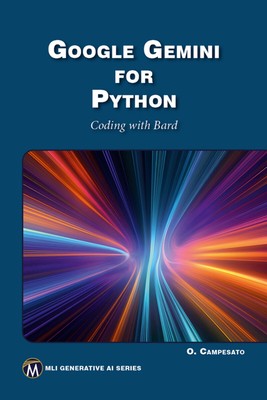
- We will send in 10–14 business days.
- Author: Oswald Campesato
- Publisher: Mercury Learning and Information
- ISBN-10: 1501522744
- ISBN-13: 9781501522741
- Format: 15.2 x 22.9 x 1.1 cm, minkšti viršeliai
- Language: English
- SAVE -10% with code: EXTRA
Reviews
Description
This book provides a bridge between the worlds of Python 3 programming and Generative AI, equipping readers with the skills to navigate both domains with confidence. It begins with an introduction to fundamental aspects of Python programming, which include various data types, number formatting, Unicode and UTF-8 handling, and text manipulation techniques. In addition, you will learn about loops, functions, data structures, NumPy, Pandas, conditional logic, and reserved words in Python. Further chapters show how to handle user input, manage exceptions, and work with command-line arguments. The text then transitions to the realm of Generative AI, discussing its distinction from Conversational AI. Popular platforms and models, including Bard (now called "Gemini") and its competitors, are presented to give readers an understanding of the current AI landscape. The book discusses the capabilities of Bard, its strengths, weaknesses, and potential applications. Finally, you will learn how to generate a variety of Python 3 code samples via Bard.
FEATURES:- Includes a chapter on how to generate a variety of Python 3 code samples via Gemini
- Covers basic concepts of Python 3 such as loops, conditional logic, reserved words, user input, manage exceptions, work with command-line arguments, and more
- Includes companion files for downloading with source code and figures
EXTRA 10 % discount with code: EXTRA
The promotion ends in 22d.23:43:03
The discount code is valid when purchasing from 10 €. Discounts do not stack.
- Author: Oswald Campesato
- Publisher: Mercury Learning and Information
- ISBN-10: 1501522744
- ISBN-13: 9781501522741
- Format: 15.2 x 22.9 x 1.1 cm, minkšti viršeliai
- Language: English English
This book provides a bridge between the worlds of Python 3 programming and Generative AI, equipping readers with the skills to navigate both domains with confidence. It begins with an introduction to fundamental aspects of Python programming, which include various data types, number formatting, Unicode and UTF-8 handling, and text manipulation techniques. In addition, you will learn about loops, functions, data structures, NumPy, Pandas, conditional logic, and reserved words in Python. Further chapters show how to handle user input, manage exceptions, and work with command-line arguments. The text then transitions to the realm of Generative AI, discussing its distinction from Conversational AI. Popular platforms and models, including Bard (now called "Gemini") and its competitors, are presented to give readers an understanding of the current AI landscape. The book discusses the capabilities of Bard, its strengths, weaknesses, and potential applications. Finally, you will learn how to generate a variety of Python 3 code samples via Bard.
FEATURES:- Includes a chapter on how to generate a variety of Python 3 code samples via Gemini
- Covers basic concepts of Python 3 such as loops, conditional logic, reserved words, user input, manage exceptions, work with command-line arguments, and more
- Includes companion files for downloading with source code and figures


Reviews